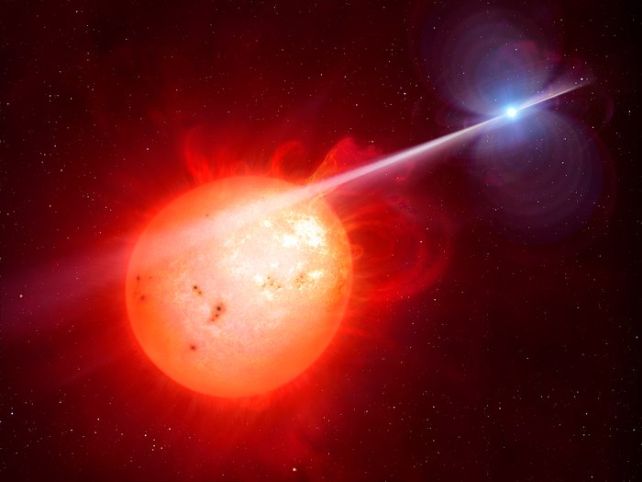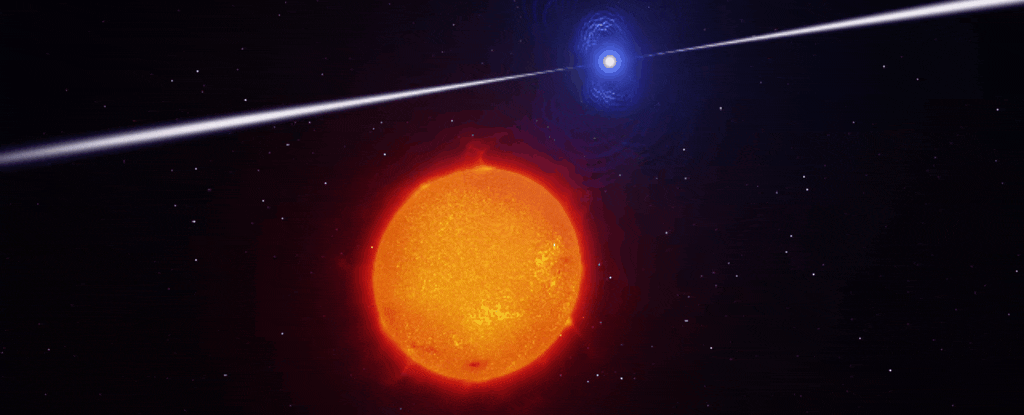A newly discovered star just 773 light-years away belongs to one of the rarest categories in the Milky Way.
J1912-4410 is a white dwarf pulsar, a type of star so rarely seen that only one other is known in the entire galaxy. Its discovery confirms that these stars exist in a class of their own, and it gives us a new tool for interpreting not just the evolution of stars but also the strange signals detected throughout the Milky Way that defy conventional explanation.
The discovery seems to confirm that the magnetic field of a white dwarf is generated by an internal dynamo, similar to how Earth's liquid core generates its magnetic field but way more powerful.
"The origin of magnetic fields is a big open question in many fields of astronomy, and this is particularly true for white dwarf stars," explains astrophysicist Ingrid Pelisoli of the University of Warwick in the UK.
"The magnetic fields in white dwarfs can be more than a million times stronger than the magnetic field of the Sun, and the dynamo model helps to explain why. The discovery of J1912-4410 provided a critical step forward in this field."
Traditionally, pulsars are a type of dead star called neutron stars. They are what's left of massive stars between about 8 and 30 times that have run out of hydrogen fuel to fuse in their cores. The star ejects its outer material, and the core, no longer supported by the outward pressure of fusion, collapses under gravity into an ultradense object.
In the case of a pulsar, the neutron star spins rapidly, down to millisecond scales, while beams of electromagnetic radiation, generated by the rapid spin and powerful magnetic field, erupt from the magnetic poles. As the star spins, these beams sweep past our field of view like a cosmic lighthouse, making the star appear to pulse.

White dwarfs are a similar kind of stellar remnant. They're the collapsed cores of dead stars below around 8 solar masses. They're less dense than neutron stars and have larger radii. As far as we knew until just a few years ago, they also don't seem to turn into pulsars.
Then, in 2016, astronomers found what they called the first white dwarf pulsar, a star named AR Scorpii. AR Scorpii is a little bit different from a traditional pulsar. It's a white dwarf in a binary system with a red dwarf star. As it spins, its beams sweep past the red dwarf, causing it to brighten across multiple wavelengths on regular, 1.97-minute time frames; the pulsations we see are not from the white dwarf's beams directly but from the effect those beams have on the red dwarf companion.
AR Scorpii's system, however, defied our understanding of white dwarfs, with a spin rate usually only achieved via a mass transfer from the red dwarf, which causes the white dwarf to spin faster. The white dwarf's spin-down rate, however, suggests a powerful magnetic field, which would require a considerable amount of mass to be transferred to reach the white dwarf's dizzying spin rate.
One possible explanation is the changes white dwarfs undergo as they cool and crystallize. It's possible that the AR Scorpii white dwarf started with no magnetic field, allowing the spin rate to increase as it slowly stole mass from the red dwarf.

However, as the white dwarf cools, interior density changes combined with convection as heat escapes could have kickstarted a dynamo. This rotating, conducting, and convecting fluid converts kinetic energy into magnetic energy that spins out from the object as a magnetic field.
We don't really know what happens inside white dwarf stars; we know they're incredibly dense, around the mass of the Sun packed into an object the size of Earth, and only the refusal of electrons to occupy the same state below a certain critical threshold keeps it from collapsing further, but what that looks and how it behaves is purely hypothetical. AR Scorpii could mean that the interior of a white dwarf is capable of generating a dynamo.
But a sample size of one star makes it impossible to confirm, so Pelisoli and her colleagues searched for more. They combed survey data looking for stars with similar characteristics to AR Scorpii. Then, they followed up with their candidates to see if they matched.
"After observing a couple dozen candidates, we found one that showed very similar light variations to AR Scorpii. Our follow-up campaign with other telescopes revealed that every five minutes or so, this system sent a radio and X-ray signal in our direction," she says.
"This confirmed that there are more white dwarf pulsars out there, as predicted by previous models."

The newly discovered J1912-4410 also fit with several other characteristics of the dynamo model. White dwarf pulsars should be relatively cool, showing that crystallization is occurring inside, and close enough to their binary companion that mass transfer could have happened in the past to increase the white dwarf's spin. J1912-4410 matches these characteristics perfectly.
A second study led by astrophysicist Alex Schwope of Leibniz Institute for Astrophysics Potsdam in Germany independently found J1912-4410 in data from the X-ray space observatory eROSITA. They, too, concluded that the object is a white dwarf pulsar like AR Scorpii, suggesting strongly that there are more of these objects out there.
And it could help astronomers resolve ongoing mysteries. For example, something near the galactic center is flashing radio waves on regular, 18.18-minute beats. That could be a white dwarf pulsar, perhaps sans binary companion, as it doesn't tick all the boxes seen in AR Scorpii and J1912-4410.
But the discovery gives us a new tool for understanding the strange things we detect in the Milky Way galaxy.
"We are excited to have independently found the object in the X-ray all-sky survey performed with SRG/eROSITA," Schwope says. "The follow-up investigation with the ESA satellite XMM-Newton revealed the pulsations in the high-energy X-ray regime, thus confirming the unusual nature of the new object and firmly establishing the white dwarf pulsars as a new class."
The two papers have been published in Nature Astronomy and Astronomy & Astrophysics.
